

One of the most important components in of transmitting system is the antenna feeder system. If you are fortunate enough to have 500 watts then a few watts here or there may not mean very much to you, but there are several advantages to using a balun:
Many amateurs simply connect the two ends of a co-axial cable to a center-fed ballanced antenna. The problem with this is that the co-ax braid current must be equal to the co-ax center conductor current. The co-ax braid therefore radiates "cocking up" the radiation pattern of the antenna, as well as bringing RF back into the shack (past the neighbours telly) and on to the shack earth. This is when you burn your lips on the microphone if using much RF power. So what are we going to do about it?
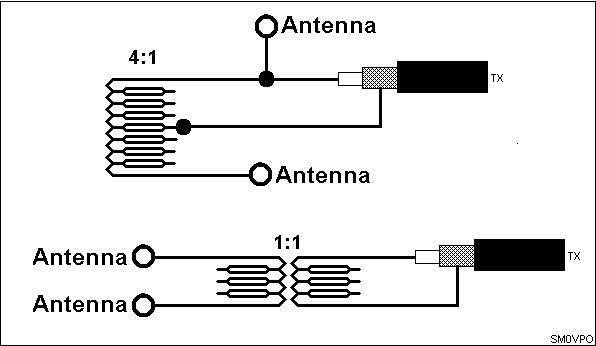
Here you see two methods, the first is a simple AUTO-TRANSFORMER. The RF voltage is doubled and ballanced about a center point. This method will increase the antenna feed impedance by four so with a 50 ohm feeder it is suitable for driving 200 ohm impedance antennas, such as folded dipoles. The second method is simple transformer isolator - crude but effective.
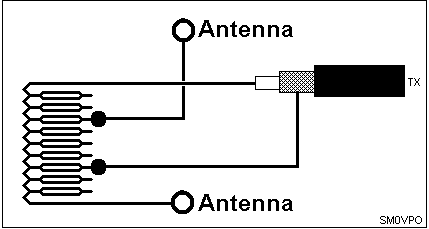
By tapping the coil it is possible to achieve a 1:1 impedance ratio and improve the effect of the second crude method. In practice each winding will be identical to all the others and this can be achieved by twisting together two insulated wires and wrapping a few turns round a bit of ferrite.
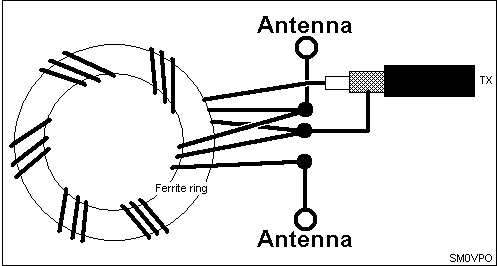
Here we see three pieces of wire twisted together and coiled upon a ferrite ring. This method enables you to have a 1:1 impedance ratio for feeding low impedance antennas such as half-wave HF antennas. This transformer balun has a very wide bandwidth and is suitable throughout the complete HF spectrum. The transformer may be almost any ferrite ring for up to 50 watts or so.
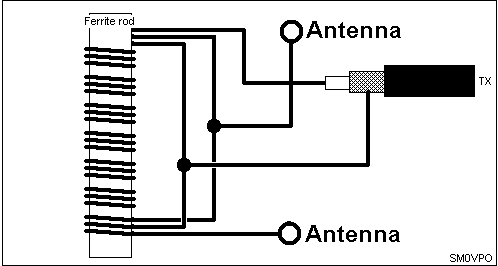
Here we see the same balun wound on a bit of ferrite from an old transistor radio set. This will also work well but the power handling capacity may be reduced a little.
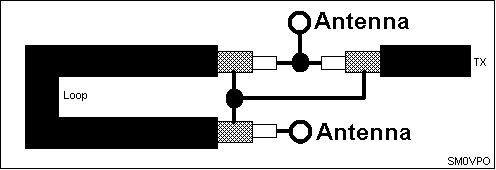
For VHF work the most common ballanced antenna is the folded dipole and has an impedance somewhat higher than 50 ohms. A 4:1 balun is the most suitable for feeding balanced antennas at VHF. Ferrites do not perforn so well at VHF but a half-wave co-axial cable will do the job. The correct length of the cable loop is cable velocity-factor multiplied by a calculated 1/2 wavelength. This type of balun is quite frequency conscious but the VHF and UHF bands are very narrow, expressed as a percentage of frequency.
A practical example for 145 MHz using URM75 (velocity factor = 0.66): calculated 1/2 wavelength = 1035mm. 1035 multiplied by 0.66 = 683mm.
It is better to cut the cable a couple of centimeters too long and trim it to the correct length using a Grid Dip Oscillator. Short-circuit the co-ax cable inner to outer at both ends, forming one of them into a small loop. Check the dip occurs at the center frequency you are interested in. If you have difficulty with the GDO at (for example 433 MHz) then open-circuit one end of the balun and check the dip at 1/2 the operating frequency (example = 216.5 MHz). This co-axial balun works equally well at HF but the bandwidth may be a bit narrow and a balun for 1.8MHz would use half a 100 meter roll of cable!!.
Well, this is about enough to get you started playing with baluns. There are many books on the subject, by far the best I have seen is the trusty ARRL Radio Amateurs Handbook. So, have fun and don't get your lips burned, de HARRY, Upplands Vasby, Sweden.
